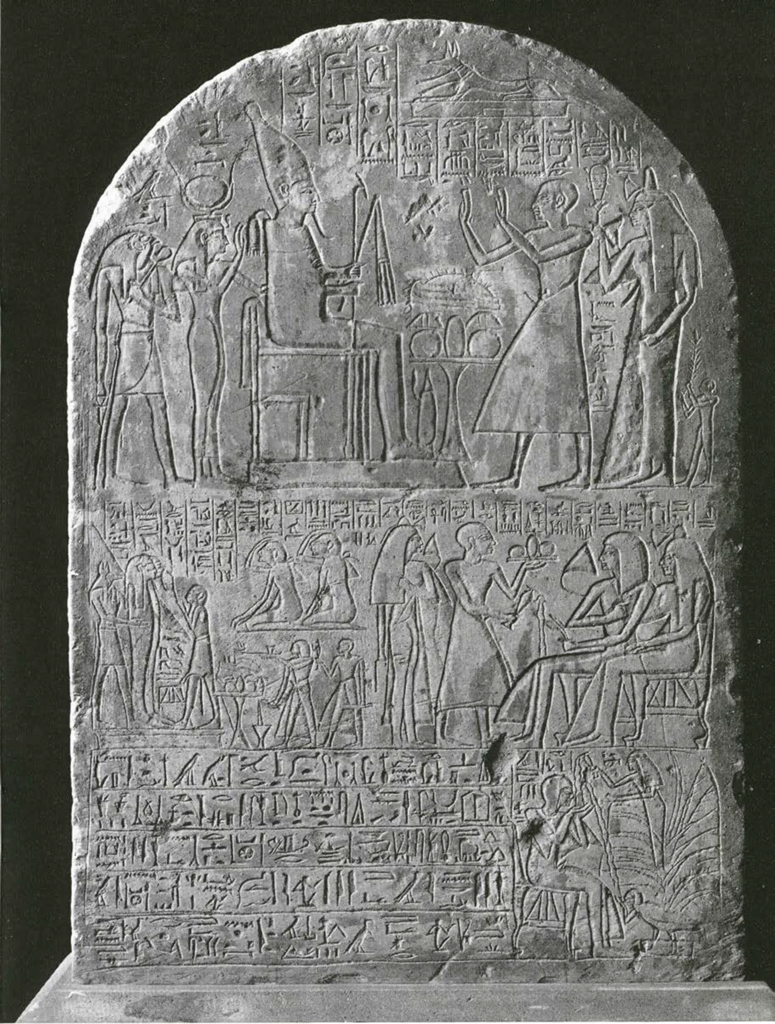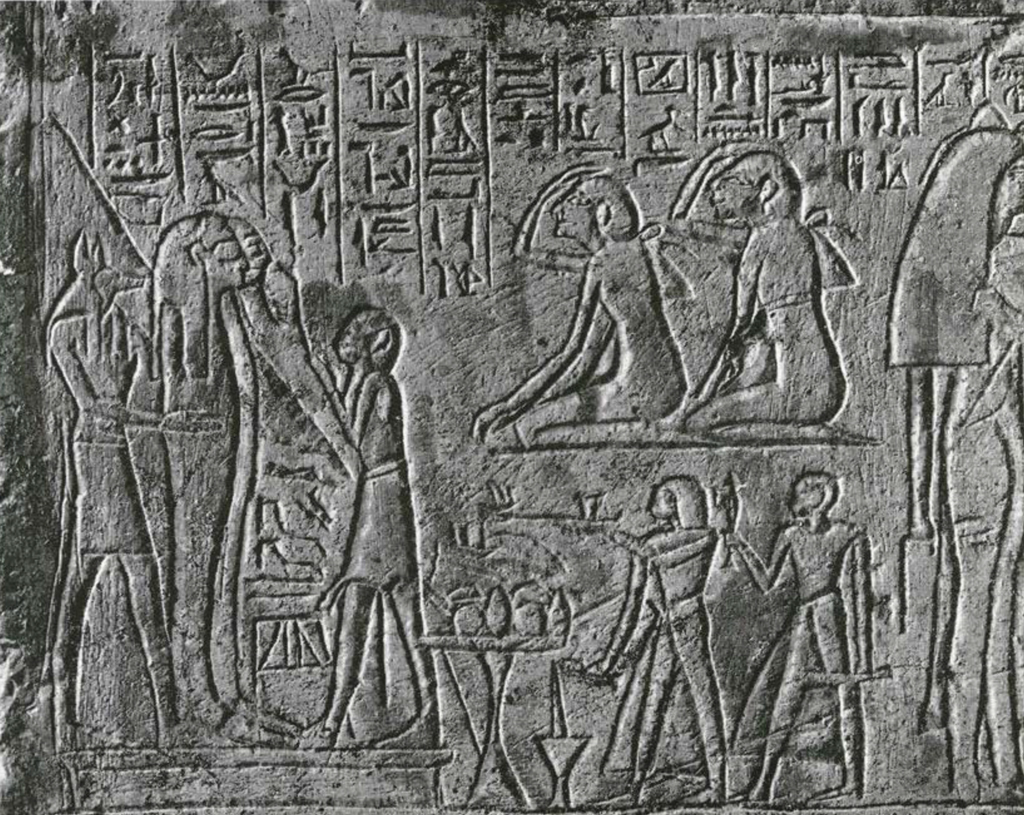THE tombstone shown in Plates VIII, 1 which recently was acquired for the University Museum, is unusually informative. While most tombstones of the New Kingdom only show the tomb owner in adoration before Osiris and, in a lower register, receiving the gifts of his children, this one contains, in addition, a number of scenes which were mostly reserved for the walls of the tomb chamber.

Museum Object Number: 40-19-2
Image Number: 31271
The scene of adoration, as had become customary since about the middle of the 18th dynasty, 2 plays the first role and fills the upper half of the stela. We see Shamaya, 3 whose shaven head shows him to be a priest, with his arms raised in prayer before “Osiris, the lord of eternity, the ruler of everlastingness, the good God, lord of Abydos.” The god is seated on his throne and holds the ‘flail’ and a long staff which symbolizes happiness. He is protected by his wife, “Isis, the mistress of heaven,” who wears the uraeus-serpent and the sun-disk between the horns of her4 sacred animal, the cow. Behind her, we see their son “Horus, the protector of his father,” with the falcon’s head, the signs of life and of rulership in his hands. Opposite to them Shamaya is also accompanied by his family. His wife, “lady of the house Baket-Ese,” raises the sistrum, which she was accustomed to rattle in the cult of Hathor. Their naked little son raises with both his hands a tall stem with many leaves and the bud of a Hower. His name is not given. The father’s prayer is incised above him: “Praise to thee, Osiris, who presides over the Westerners, 5 give me the sweet wind daily!” 6
The lower half of the stela is divided into two registers. In the upper one we see, to the left, scenes of the funeral rites performed for Shamaya. In front of his tomb, which is indicated by the sloping side of a pyramid, his two mummy-shaped coffins7 are standing side by side upon a low platform. A priest, wearing a mask of the jackal-headed funerary god, Anubis, attends them. Another priest, clad in a leopard skin, performs the ritual of “opening the mouth”, and says: “Opened be thy mouth with the ‘great sorceress’, 8 with which (the mouth of) 9 every god and every goddess is opened, Osiris Shamaya!” Through this ritual the deceased is supposed to be enabled to speak again, and to take the food which is piled up on a low altar. Two more priests are approaching this altar, carrying an incense-burner and a vase used for libations. Above them, two women clad in the short shawl of mourners, are kneeling. They touch the ground with the left hand and hide their wailing faces with the right hand. They are probably the wife of Shamaya and another relative. To the right Shamaya and his wife are seen again, but they are not, as we might expect from other tombstones, the seated couple, but the standing one. 10 Shamaya brings “bread and milk” to his parents, Ramose and Meryet-Re, who are comfortably seated on a broad chair with lion’s feet. Baket-Ese, who here has the epithet “greatly praised of Hathor”, accompanies him. She holds a lotus-bud in her right hand, her left hand seems to touch her wig.

(a) The Goddess Nut, in a Sycamore Tree, pours water to the deceased and his soul.
Museum Object Number: 40-19-2
The main part of the lowest register is taken up by an inscription. In this Osiris, Isis, Horus, Anubis11 and “the Upper Egyptian Wepwavet, the leader of the two lands” are asked to give “all good and pure things, water, wine and milk, clothing and ointment” to Shamaya, “greatly praised of his lord” and to allow him “to enter and to leave in the cemetery like the followers of the lord of the sacred land and to cross peacefully in a boat to Abydos together with the (other) blessed ones.” The rest contains a short prayer of Shamaya. Finally, in the right hand corner, we have a charming scene. This time, Shamaya himself is seated in an easy chair. He wears the modish upper garment and has his head covered with a tight-fitting cap. He leans gently forward, in order to receive in the curved palms of his hands the refreshing water which Nut, the friendly patron of the deceased, pours out of a tall, narrow vase. The goddess rises out of a sycamore-tree, and two of the four strands of water which issue from her vase, fall down to the ground, where a strange creature, Shamaya’s soul, a bird with human head and arms, receives its part of the refreshments.
The artistic execution of most of the incised reliefs is fairly good but not outstanding. The smaller figures in the two upper registers were done with less care than the larger ones, and the goddess in the tree has been very summarily done indeed. The preservation of the stela is almost perfect. The original colors, however, which may have concealed some apparent inaccuracies12, have disappeared entirely.
In two details the sculptor has committed rather awkward mistakes. The milk which Shamaya is pouring out in the second register, instead of flowing into a vase or upon an altar, hits the knees of his father. The offering table in front of Osiris seems to have been entirely forgotten in the original composition. When the sculptor later inserted it, he made it too wide for the space at his disposal, and thus it seems to slide down from the slanting edge of the pedestal, on which the throne of the god is erected.
Judging from the style of the reliefs and inscriptions, this tombstone belongs to the time of the 19th dynasty (ca. 1350-1200 B. C.). That it once stood in the famous cemetery of Abydos in Upper Egypt is shown by the desire of Shamaya, who evidently lived on the Eastern bank of the river, to “cross over” after his death “to Abydos”.13
H. R.

(b) Funerary services and mourners before the mummiform coffins.
Museum Object Number: 40-19-2
It is of limestone and measures 0.84 m. in height and 0.61 m. in breadth. Chisel marks on the sides and in the back indicate that it once was let into the wall of a tomb. The stone, in earlier years, formed part of an English private collection, see E. A. Wallis Budge, Some Account of the Collection of Egyptian Antiquities in the Possession of Lady Meux, second edition (London, 1896) p. 112 and Pl. IX D. As I learned from Mr. John D. Cooney, it is also mentioned in the Catalogue of Antiquities, the property of W. R. Hearst (published by Sotheby and Co., London. July 1939), p. 7, No. 22. ↪
For a characteristic example of the first half of this dynasty, see The Journal of the Walters Art Gallery, Vol. II (Baltimore, 1939). p. 20. ↪
The reading of this name is not certain. Dr. W. Federn suggests it should read “the merchant Maya”. The name is always accompanied by a hieroglyph, which shows the bearer to be of foreign origin. ↪
Isis early became identified with the goddess Hathor. ↪
That is the deceased. ↪
It was the great desire of the Egyptians that they would be enabled to enjoy the refreshing breeze of the north wind even in the hereafter. ↪
For greater protection, it had become customary in the New Kingdom to enshrine the mummy-shaped wooden coffin, which contained the body, in an outer coffin of the same
type. Both coffins show the ceremonial beard. ↪
An epithet of the instrument, which was used for the ritual. Other instruments are seen above a wooden box, which is meant to contain them. For the funerary rites and
their meanings see W. C. Hayes, The Tomb of Sebek-mose. ↪
These words have been omitted by the carver. ↪
In their dress they resemble closely the standing couple above, except the garment of the lady is shorter and does not touch the ground. ↪
Anubis probably is represented by the jackal, lying on a stylized temple in the lop of the stela. ↪
See the stems of the lotus flowers, in the second register, which Ramose and Baket-Ese are smelling, and the strange treatment of Meryet-Re’s right arm. ↪
“This provenience is corroborated by the unusual designation of Isis (in a second inscription, above the head of Osiris!) as mistress of the Thinite district, to which Abydos belonged”. ↪

